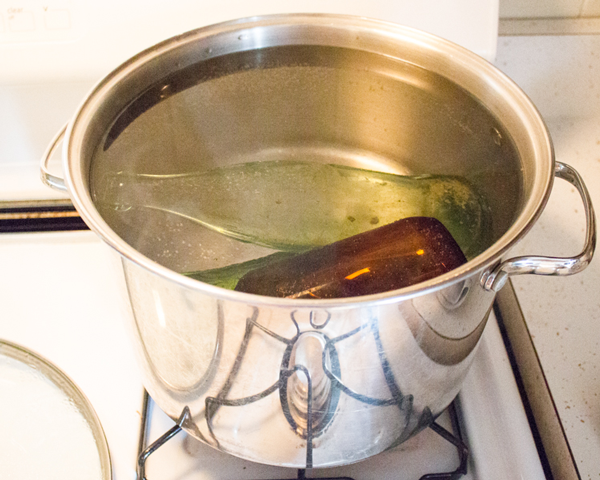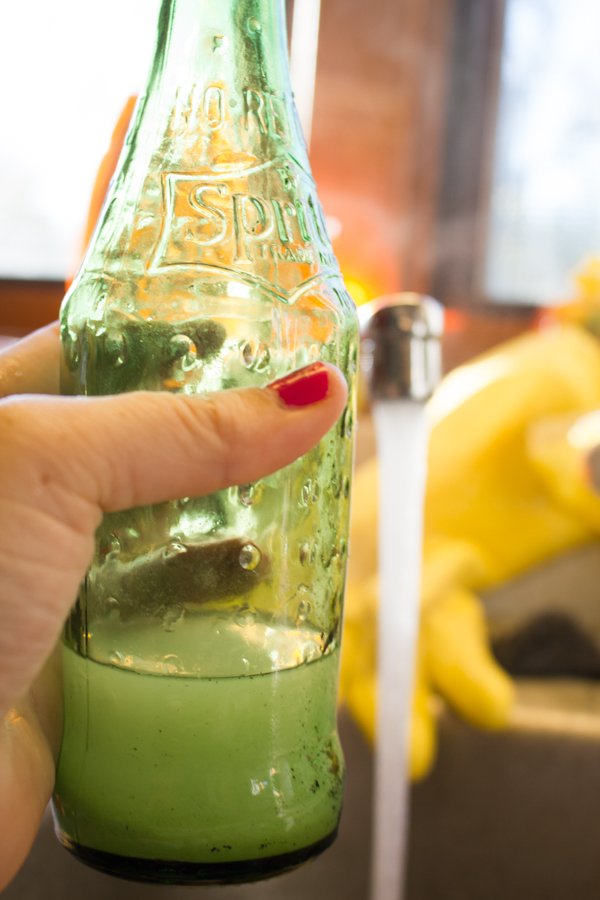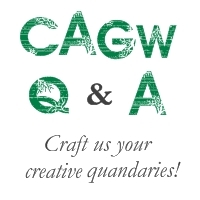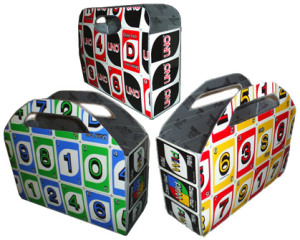Do you ever see old glass bottles, maybe at a flea market, maybe scrounged from an old dump site (we have one of those back in our woods, sigh…), and think, “That bottle would be so great… IF it wasn’t covered in 50 years’ worth of grime?” Here’s how to clean old glass bottles so they’ll look like new.
It’s actually not *that* hard to clean old glass bottles. It takes some babysitting to clean them, and some TLC, but it’s not like you’ve got to stand over the sink and scrub for half an hour like you’re dealing with a casserole dish after a delicious lasagna dinner. The key to how to clean old glass bottles is to be quite gentle. Although they may not come out perfect and sparkling in the end–they HAVE spent five decades lying in a field, after all–they’ll certainly come out loads better and ready for their second life with you.
How to Clean Old Glass Bottles
Here’s what you do:
 1. Do your research. Don’t you craft with a national treasure! If you happen upon something precious, then even cleaning it could do harm. For bottles, I like to start with this bottle identification site to narrow down what I have, and then research on from there–I don’t feel like I have to figure out *exactly* what I have, necessarily, but I do feel like I have to make sure it’s not valuable before I fool with it.
1. Do your research. Don’t you craft with a national treasure! If you happen upon something precious, then even cleaning it could do harm. For bottles, I like to start with this bottle identification site to narrow down what I have, and then research on from there–I don’t feel like I have to figure out *exactly* what I have, necessarily, but I do feel like I have to make sure it’s not valuable before I fool with it.
The bottles in these photos, for instance, are all from the 1960s; I’ve got a Coca-Cola bottle (a hobbleskirt bottled in Cincinnati, in case you’re interested), a Sprite bottle, and a stubbie ale bottle from Louisville, Kentucky.
2. Soak the bottles. Pour a quite generous glug of vinegar into the bottom of a large pot, then fill it with water. Also fill the bottles with water (so that they won’t float), and gently settle them down into the pot.
Heat the pot (but don’t let it boil!) for a couple of hours, then turn off the burner and let the bottles soak overnight.

3. Scrub the insides of the bottles. Empty the water from each bottle, then pour an again quite generous amount of salt into the bottle, and pour in just enough warm water to make a saltwater slurry–you want the salt to easily flow around, but not to dissolve.
Put your finger over the opening of the bottle, then shake it like a Polaroid picture. Shake vigorously, turning the bottle around every which way, and watch in amazement as the salt gently scours away all the rest of the grime and residue from the inside of the bottle.
When the inside of the bottle is squeaky clean, rinse out the saltwater very, very well–don’t want to leave any residue after all that work!
4. GENTLY scrub the outside of the bottle. Probably, those first two steps are all you’re going to need to get your bottles looking nice. My bottles start off in such rough shape, however–remember that back-of-the-woods dump site?–that they’ll sometimes need some abrasive action on the outside, too.
You don’t want to risk scratching your bottle with a scouring pad, so the trick here is to use something like this dish scrubber upcycled from mesh produce bags. A scrubber with plastic… um, scrubbies?… won’t scratch your glass, but will get those last bits of dirt off your bottle.
Remember that you’re working with old stuff, here, so don’t expect perfection–even in my After photo above, there’s definitely still some discoloration and some scuffs on these bottles. But your bottles are clean, so you can craft with them, and they’re sanitary, so you can store spices in them, and they’re gorgeous, so even if you do none of the above, you can still sit them on your windowsill and admire them every sunny day.










Great idea for cleaning bottles. I’ll give you a better option than salt for cleaning the insides: sand. It won’t dissolve, scrubs gently without ruining the interior and can be reused if you’re feeling patient.
Ooh, that’s smart! And I bet you can use it as the abrasive for the outside of the bottles, too. Having my own private 1960s-era dump at the back of my property, I often find myself cleaning up an entire bucketful of glass bottles, and I bet the sand would really come in hand in that situation.
Pingback: Clean Old Glass, Make New Crafts
Pingback: Feelgood Style | Sustainable fashion reporting, organic beauty tips, DIY projects + tutorials, + natural product reviews.
Pingback: Crafting a Green World | The home for green crafts and tutorials!
After washing with soapy water, rinse well, and fill your bottle one fifth of the way with white vinegar. Fill the rest with water, let it stand overnight, and in the morning thoroughly rinse it out.
You need to correct your link to your etsy site in your About The Author section 🙂 I found it though, but the link is broken.
Ooh, thanks! [goes on 40-minute internet journey to figure out where author dashboard is, guess password (three tries!), and fix link]
Pingback: Sustainablog | Jeff McIntire-Strasburg has been blogging a greener world via sustainablog since 2003!
I have a few old bottles that use to have calligraphy ink in them. After using this process will the clean jars be safe to put items such as spices and herbs in?
I don’t think so, just because those bottles wouldn’t necessarily have been food-safe to begin with. This process will clean them, but it won’t remove any contaminants, such as lead, from the bottle itself, nor would it remove any contaminants from the ink that have leached into the glass. I’d only trust bottles that were originally used for food or drinks, and whose provenance is known.
Pingback: Vodka Cleaning Recipes - Crafting a Green World
I’ve recently found a whole bunch of old bottles in a backyard garbage pit like you, your instructions will be great to clean them up. I notice that a few of them that have their caps on still have liquid/sludge inside them. Do you ever deal with that and have any tips on how to get that out without having to smell it as I’m sure it will be rank?
Lol, I think you’re just going to have to tough it out. I’ve had that with a few of my bottles, and honestly, the sludge hasn’t really smelled that bad–just… organic, you know?
Except that old medicine or poisons bottles may have some extremely toxic residues in them. These were mostly green or bottles (with some brown) and may have POISON or DO NOT TAKE embossed on the bottle. Anyways do not assume contents are harmless. Treat as highly toxic and take suitable precautions.
Thanks for the great tips on cleaning out old bottles. Now I have a working knowledge I can use, so I won’t have to pass on rare bottles just because they are dirty, dug relics. And I like the idea of using sand. And just for the record… there are different grain coarsness of sands. Some are so fine they are used in polishing compounds. Like comparing fresh water creek bottom fine softer silt compared with coarser abrasive sands used in mixing cement or mortar mix. ‘Let the feel of the flow be your guide’… “then use the force, Luke”. If water flowing silt can smooth and polish river stones over time… It could gently remove scratches in glass… right?
Any suggestions on how to get a metal lid off a mason jar that has been on there and buried in the ground for probably 50 years? It’s not twisting off so I can’t even get it nice looking because it was buried with stuff in it that you can see through the glass.
Hey Betty!
Try these tips: https://www.houzz.com/discussions/1969425/can-rusted-rings-on-canning-jars-be-removed
I had to use tin snips for mine, as they’re soft, contain lead, and had to be thrown away, anyway. Do the ones you found have the milk glass centers? All I wanted was the milk glass cover from the middle, and the jar. Absolutely beautiful in the end!!! Best of luck and happy hunting!
Soak in CLR (50 clr & 60 water) over night then gently scrub. It may take another da or two but its very gentle and works well. I’ve done a lot of civil war era knives and forks and I’ve got an old tonal truck that I took apart that’s soaking in a 5 gallon bucket now.
Like using salt or sand, I have used small stones in the solution inside glass jars to help remove stuck on crud.
Now I’m looking for what to use to remove rust from inside a milk bottle. I’m sure phosphoric acid would work but don’t have a source to purchase it locally. Will vinegar work? Citric acid? Bleach?
I put in vinegar and water mix, 3 parts water, 1 part vinegar, let it sit, with occasional shaking, for 2 days and a lot of the rust came out, the rest didn’t want to come out even w/a bottle brush. Dumped the mixture and put in 2 rounded teaspoonfuls of powdered citric acid and about 600 ml of water. After sitting for 4 days w/occasional stirring all the rust came out.
Then I got to thinking that maybe CLR would have worked. Will try it next time, if there is a next time.
Wow…this worked beautifully! I have a couple of suggestions of my own. (1) I used a small funnel to transfer salt from one bottle to another in order to avoid waste. (2) I used the salt slush on the outside of some of the bottles to get off grime that the initial bath didn’t remove.
I found my bottles on the 100+ yr old farm my Mom grew up on (she’s now 87 and the youngest of 6) buried in the dirt with a treasure trove of other items. I don’t care so much about the value of these bottles because they are priceless to me no matter what! I just wanted to preserve them enough to use them in craft projects for my home. Thank you so much for sharing this how-to info. I am thrilled with the outcome!
This may seem like a dumb question, but if they don’t have labels on them, can’t you run them through dishwasher? i’v done that with old clear bottles and jars and see no damage or issues – just sparkling glass. Is there some reason they can’t be cleaned this way? I don’t want to hurt them, so I’m asking in case there is something I don’t see going on
Thank you for the tips. Question: will vinegar remove Applied Color Labeling (ACL) labels? Most soda bottles from the 50s and later had logos painted on. The paint is very durable, but I’m hesitant to dip it in vinegar for too long because I don’t want to remove the paint. The bottles I’m looking to clean are 16oz RC Cola bottles from 1966. Found them in the dirt near Palm Springs. They’re in amazing shape for being in the desert dirt for decades. Not much fading on the labels, but the glass is cloudy.